

Attachment Theory: How Early Attachments Shape Behavior. Attachment theory is focused on the relationships and bonds between people, particularly long-term relationships including those between a parent and child and between romantic partners.
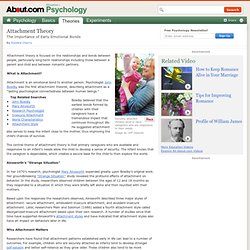
What is Attachment? Attachment is an emotional bond to another person. Psychologist John Bowlby was the first attachment theorist, describing attachment as a "lasting psychological connectedness between human beings. " Bowlby believed that the earliest bonds formed by children with their caregivers have a tremendous impact that continues throughout life. He suggested attachment also serves to keep the infant close to the mother, thus improving the child's chances of survival.
The central theme of attachment theory is that primary caregivers who are available and responsive to an infant's needs allow the child to develop a sense of security. Ainsworth's "Strange Situation" Psychopaths vs. Sadists: Brain Science, Public Fascination. Psychopathic serial killers are a source of infinite public fascination.
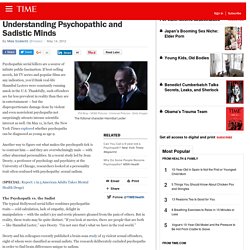
If best-selling novels, hit TV series and popular films are any indication, you’d think real-life Hannibal Lecters were constantly running amok in the U.S. Thankfully, such offenders are far less prevalent in reality than they are in entertainment — but the disproportionate damage done by violent and even nonviolent psychopaths not surprisingly attracts intense scientific interest as well. On May 11, in fact, the New York Times explored whether psychopaths can be diagnosed as young as age 9.
Increased Frontotemporal Activation During Pain Observation in Sexual Sadism: Preliminary Findings. Harry Harlow and the Nature of Love. During the first half of the 20th century, many psychologists believed that showing affection towards children was merely a sentimental gesture that served no real purpose.
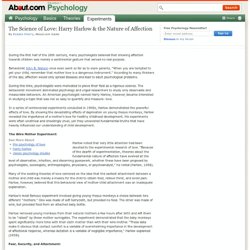
Behaviorist John B. Watson once even went so far as to warn parents, "When you are tempted to pet your child, remember that mother love is a dangerous instrument. " According to many thinkers of the day, affection would only spread diseases and lead to adult psychological problems. During this time, psychologists were motivated to prove their field as a rigorous science. The behaviorist movement dominated psychology and urged researchers to study only observable and measurable behaviors. In a series of controversial experiments conducted in 1960s, Harlow demonstrated the powerful effects of love. Attachment theory. Www.psychology.sunysb.edu/attachment/online/inge_origins.pdf. A Brief Overview of Adult Attachment Theory and Research. A Brief Overview of Adult Attachment Theory and Research R.
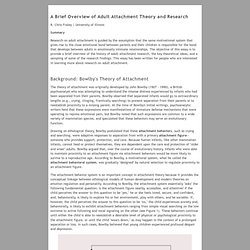
Chris Fraley | University of Illinois Summary Research on adult attachment is guided by the assumption that the same motivational system that gives rise to the close emotional bond between parents and their children is responsible for the bond that develops between adults in emotionally intimate relationships. Maternal Deprivation Theory. By Saul McLeod published 2007 John Bowlby (1907 - 1990) was a psychoanalyst (like Freud) and believed that mental health and behavioral problems could be attributed to early childhood.
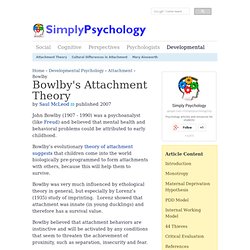
Monkeys. Neurobiological basis of psychopathy. R.
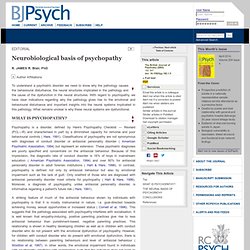
JAMES R. Blair, PhD + Author Affiliations To understand a psychiatric disorder we need to know why the pathology causes the behavioural disturbance, the neural structures implicated in the pathology and the cause of the dysfunction in the neural structures. With regard to psychopathy, we have clear indications regarding why the pathology gives rise to the emotional and behavioural disturbance and important insights into the neural systems implicated in this pathology. Psychopathy is a disorder, defined by Hare's Psychopathy Checklist — Revised (PCL—R) and characterised in part by a diminished capacity for remorse and poor behavioural controls ( Hare, 1991). A striking feature of much of the antisocial behaviour shown by individuals with psychopathy is that it is mostly instrumental in nature, i.e. goal-directed towards achieving money, sexual opportunities or increased status ( Cornell et al, 1996).
Hare Psychopathy Checklist. The Hare Psychopathy Checklist-Revised (PCL-R) is the psychological assessment most commonly used to rate psychopathy.[1] It is a 20-item inventory of perceived personality traits and recorded behaviors, intended to be completed on the basis of a semi-structured interview along with a review of 'collateral information' such as official records.

The PCL was originally developed in the 1970s by Canadian psychologist Robert D. Hare for use in psychology experiments, based partly on Hare's work with male offenders and forensic inmates in Vancouver, and partly on an influential clinical profile by American psychiatrist Hervey M. Cleckley first published in 1941.
A revised version, renamed the Hare PCL, was drafted in 1985 and released in 1991 as the PCL-R, with an updated second edition in 2003. Psychopathic Narcissism. Friday the 13th turns out to have been unlucky for murder defendant Joran van der Sloot.
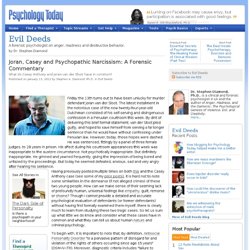
The latest installment in the notorious case of the now twenty-four-year-old Dutchman consisted of his self-serving and disingenuous confession in a Peruvian courtroom this week. By dint of delivering this brief formal statement, van der Sloot pled guilty , and hoped to save himself from serving a far longer sentence than he would have without confessing under Peruvian law.
However, today, those hopes were dashed. He was sentenced, fittingly by a panel of three female judges, to 28 years in prison.